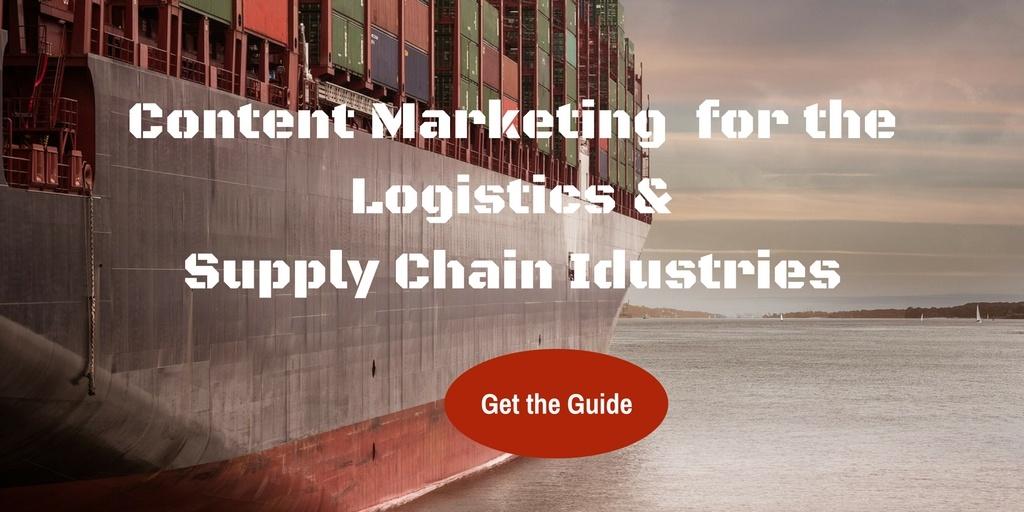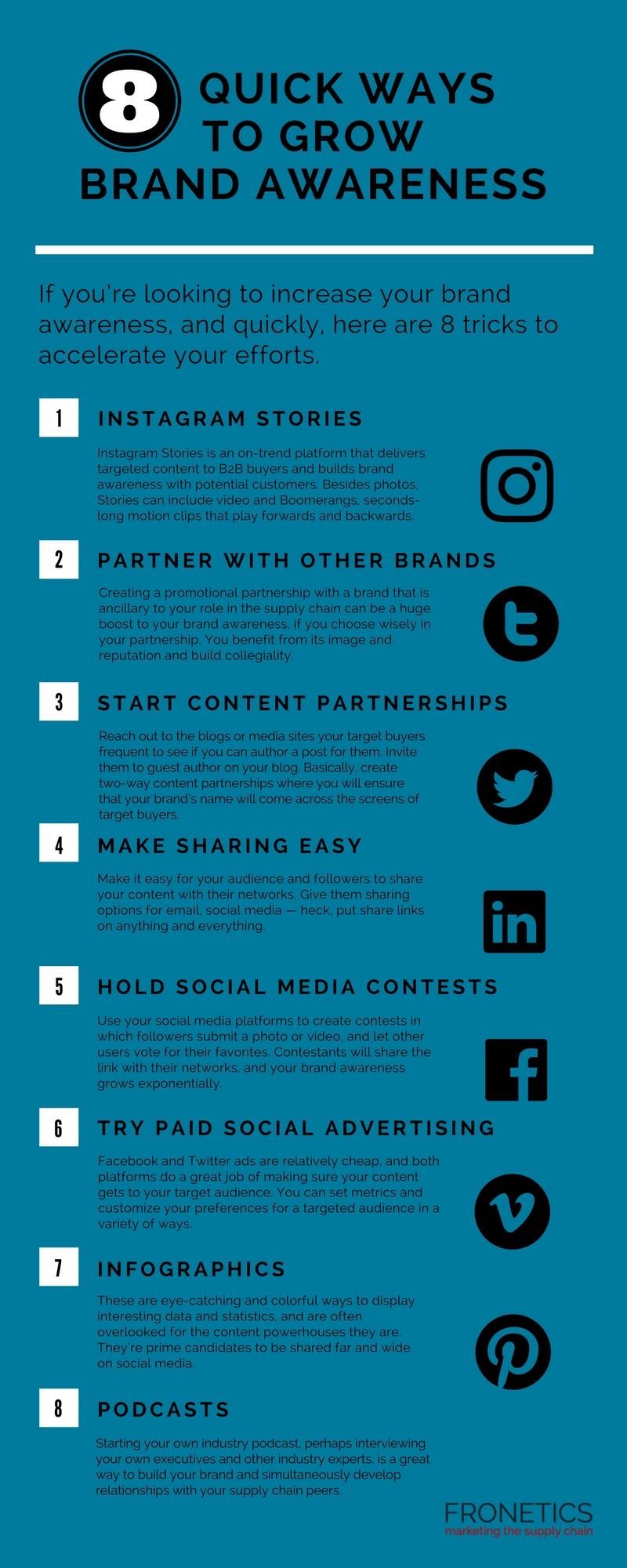
by Elizabeth Hines | Jan 16, 2019 | Blog, Content Marketing, Logistics, Marketing, Supply Chain
Updated February 4, 2025
Digital marketing for the supply chain has become necessary to position your company to not only be found online, but also to be researched and to be compared to your competition.
Highlights:
- Digital marketing uses your website, related social media, and other online industry channels to showcase your industry knowledge and experience.
- Thought leaders are the informed trusted sources in their field of expertise.
- Supply chain and logistics industries need content marketing to achieve confidence and relationship-building with buyers.
Today’s B2B buyers are researching, evaluating, and coming to conclusions about companies without a single contact with a team member or salesperson.
This kind of B2B buying landscape requires cutting edge marketing strategies to showcase nut-and-bolt industries that have survived without them for many years.
Digital marketing for the supply chain
Digital marketing for the supply chain uses your website, related social media, and other online industry channels to showcase your industry knowledge and experience (rather than trying to convince people of it with a marketing message).
With inbound digital marketing, you publish relevant, informative information to adds value to every stage of a potential customer’s buying journey.
It is the content that you publish that walks them through the initial stages of the sales process.
What should you publish? A good content marketing strategy is about understanding the questions and concerns that are particular to your customer base, and offering quality information and analysis that answers those needs.
Showcasing thought leadership through digital marketing
Discovering and meeting the needs of your customers that go beyond your products and services will catapult you in their minds as a knowledgeable, helpful “thought leader” in your industry.
Thought leaders are the informed trusted sources in their field of expertise. They have innovative ideas, can showcase their thinking, and can replicate their successes again and again.
Consider it: Your business has so much more to offer than its primary product or service. You have a team of people with a tremendous aggregate of experience, expertise, and perspectives.
Allowing your customers this sort of access to your team’s experience and knowledge provides them with tremendous value outside the sales funnel, which builds trust and cultivates lasting, fruitful relationships.
Why digital marketing?
In this B2B buying landscape, supply chain and logistics industries need content marketing to achieve a level of confidence and relationship-building with buyers that used to come from face-to-face meetings. Potential and current customers will view your company as a valuable resource for everything related to not only your products and services but to the industry as a whole.
No time to execute?
The downside? Content marketing requires significant time, labor, and resources, and it can take quite some time to start reaping benefits. Feeling overwhelmed and like you and your team can’t possibly add on more marketing? Outsourcing certain key marketing tasks allows insourcing your core competencies while delegating specialized tasks to external experts.
This post originally appeared on EBN Online.
Related posts:

by Fronetics | Nov 1, 2018 | Blog, Content Marketing, Logistics, Manufacturing & Distribution, Marketing, Supply Chain
Case studies are a perfect way to organize and present hard facts about your products and services — and they continue to be one of the most effective types of content out there.
A recent study shows that case studies far outperform other types of content. The DemandGen 2017 Content Preferences Survey Report found that 78% of B2B buyers used vendor case studies as part of their purchasing decisions in the past 12 months. 89% of B2B marketers consider customer testimonials and case studies to be the most effective kind of content to convert buyers.
Buyers are looking to “benchmark their own experiences against others who’ve tackled similar challenges,” concluded DemandGen’s report. Data is powerful stuff, and buyers know it. In fact, DemandGen’s survey indicated 48% of buyers not only prefer case studies but find them to be the most valuable type of content for research. 57% even said that they would register and share information in exchange for case studies.
Why the case study?
Beyond the obvious answer that data is important to buyers, why do they respond so well to this type of content? According to Frank Cespedes, Senior Lecturer at Harvard Business School and author of Aligning Strategy and Sales, ultimately, buyers are less interested in theory than practice: “Buyers, especially B2B buyers, want to know what others are doing with your product, not what they might do to improve productivity or other outcomes.”
[bctt tweet=”Yes, case studies are highly effective, but their success is predicated on your reputation as a thought leader and source of knowledge and expertise.” username=”Fronetics”]
As a side-note, before you jump ship on aspects of your content marketing strategy, like blogs, social media, webinars, etc., that focus on sharing ideas rather than just data, consider this: even the most impactful case study is only as useful as the totality of your brand’s content. In other words, yes, case studies are highly effective, but their success is predicated on your reputation as a thought leader and source of knowledge and expertise.
What makes a case study effective?
Not all case studies are created equal. Data presented in a confusing or incomplete way, for example, doesn’t pack the kind of punch needed to demonstrate exactly how your products and services help your buyers. A good case study should prompt the reader to explore your brand and the rest of your content. Ultimately, the goal is to show your prospect that making a change in their process will lead to better results.
As you design a case study, think about giving buyers the tools to present your products and services to decision-makers within their business. “Especially in B2B contexts,” says Cespedes, “buyers must justify a decision to others in the organization who have competing priorities for limited funds.” This is where a compelling case study comes in. Show your potential buyers how other organizations benefit from your offerings, and they have the tools to make a case for your business.
Case studies are proven to be well worth the time and energy needed to produce them. Recommendations and data from real customers have a powerful impact and should continue to be a significant component of your overall content marketing strategy.
Related posts:


by Fronetics | Aug 27, 2018 | Blog, Content Marketing, Logistics, Marketing, Social Media, Strategy, Supply Chain
Repurposed and repackaged, your existing content is a valuable asset for your sales force throughout the buyer’s journey.
If you’re a supply chain marketing professional, it’s likely that you spend a tremendous portion of your day researching, creating, packaging, and disseminating content. Your hard work is all about growing brand awareness and building your reputation as a trusted industry thought-leader — all with the goal of having that work eventually convert leads.
But, consider this: When it comes to engaging prospects and clients, only 20% of salespeople actually use content. When we know that potential buyers are far more willing to engage with someone offering them information and insight, why are B2B businesses abandoning content as soon as prospects are handed over to sales?
B2B buyers prefer content throughout the buying journey
According to DemandGen’s 2018 Content Preferences Survey Report, “Buyers are becoming increasingly more selective in the content they are consuming,” relying more on “trustworthy sources, industry influencers, and their peers to educate themselves.” And furthermore, 88% of those survey respondents want less focus on product specifics and more on the value that product can bring to their business.
[bctt tweet=”Buyers are becoming increasingly more selective in the content they are consuming, relying more on trustworthy sources, industry influencers, and their peers to educate themselves.” username=”Fronetics”]
And on the other side of that coin, according to HubSpot writer and marketing expert Bethany Cartwright, sales reps spend about 15% of their day leaving voicemails, and only about 20% of all sales emails are ever opened. “This means 80-85% of sales outreach efforts are going unnoticed by those prospects you’ve worked so hard to capture with content,” writes Cartwright.
It’s time to start leveraging your content throughout the buyer’s journey by arming your sales force with content. Before you panic at the idea of creating reams of new content, take a breath. It’s more than likely that you can repurpose your existing content, optimized to give your sales force the tools they need to close deals.
So how do you go about repurposing your content and giving your sales force the best possible tools with which to convert prospects to buyers? Web Profits co-founder and author Sujan Patel suggests “mapping content generated by your marketing team to each stage of your customer’s buying journey.” We’ve created the infographic below to help you optimize content for each of the three stages of the buyer’s journey.
Infographic: Delivering content throughout the buyer’s journey

(Made with Canva)
Related posts:


by Fronetics | May 3, 2018 | Blog, Content Marketing, Logistics, Marketing, Social Media, Strategy, Supply Chain
If you’re looking to grow brand awareness fast, here are 8 tricks to boost your efforts.
Have you ever noticed how some brands seem to have crept into popularity overnight? You’ve never heard of them, and then, all of sudden, they’re everywhere.
Their brand awareness has sky rocketed, and they’re achieving every company’s ultimate goal: Customers know about them. So what’s their secret?
Here at Fronetics, we don’t believe they have a secret. We believe that they took advantage of content marketing and its many benefits — growing brand awareness included. They were able to scale their growth in a short amount of time, a true success story for the digital era. Companies like Uber and Yelp have used these tips to implement small changes that yielded large results.
Remember, in order to grow brand awareness, you need to be proactive. It’s time to steer away from some of the traditional marketing methods, which don’t take into account how modern B2B buyers research vendors. Start putting your content marketing strategy to the test.
[bctt tweet=”To grow brand awareness fast, it’s time to steer away from some of the traditional marketing methods, which don’t take into account how modern B2B buyers research vendors. ” username=”Fronetics”]
If you’re looking to increase your brand awareness fast, there’s no better place to start than with content marketing. Check out these 8 tips for using content marketing to grow your brand awareness fast.
Infographic: 8 ways to grow brand awareness fast

(Made with Canva)
How do you grow brand awareness fast?
Related posts:


by Fronetics | Aug 31, 2017 | Blog, Marketing, Strategy, Supply Chain
As B2B buyers expect customized sales experiences, sellers can use these 3 tips to offer personalization at scale.
One of today’s biggest challenges facing B2B sellers is the increasing expectation of personalization as part of the buying experience. The seller’s task of offering personal experiences for all leads is a daunting one, particularly with limited time and marketing budgets.
As companies become increasingly focused on risk-mitigation in the buying process, they are far more inclined to trust vendors who can demonstrate that they understand and can address their specific needs and risk factors. According to Demand Gen Report’s 7th Annual B2B Buyer’s Survey, 89% of respondents stated that winning vendors “provided content that made it easier to show ROI and/or build a business case for the purchase.”
While the task of personalization may be daunting, it’s not impossible. And it’s certainly worth the effort. Here are three strategies your business can use to personalize sales pitches and make your marketing dollars work more efficiently.
3 ways to offer personalization at scale
1) Target smarter
We all know that social media platforms offer a wealth of demographic information. One of the most valuable insights it offers is intent signals: things like job changes, social posts, and hiring patterns, all of which can help your sales team identify the right time and strategy for reaching out to a potential buyer. You can use social media features built into the platforms themselves, like advanced filters and lead bots, to identify qualified leads.
Beyond identifying leads, smart targeting involves well-written and targeted online ads. According to Demand Gen’s report, “Online ads are shaping early behaviors and opinions of B2B buyers. 63% of respondents said they noticed ads from the solution provider they chose during the research phase.”
2) Demonstrate your understanding
Justin Shriber, vice president of marketing for LinkedIn sales and marketing solutions, reports that “80% of buyers don’t believe that the salespeople they deal with understand their business.” Most of this perception, Shriber says, is driven by the way salespeople converse with potential buyers. Using generic openers, and talking more than listening, reinforces this negative perception.
Set yourself apart by making sure that your opener lets the potential buyer know that you are paying attention to his/her particular needs and challenges. Make use of the information you’ve gleaned from social media to open the conversation by addressing a need or question the prospect has recently voiced.
3) Engage more closely
An important aspect of the personalization B2B buyers and consumers alike have come to expect is ongoing engagement. “When sales professionals are unable to provide ongoing value,” says Shriber, “the buyer feels no obligation to maintain a dialogue.” Continuing the conversation throughout the buying cycle is key to keeping the potential buyer invested. In addition, the most effective sellers use technology like email tracking and PointDrive to gauge whether the information they’re sharing is hitting the target. These technologies provide sales professionals with a feedback loop that they, in turn, can use to tailor future interactions.
Related posts:












